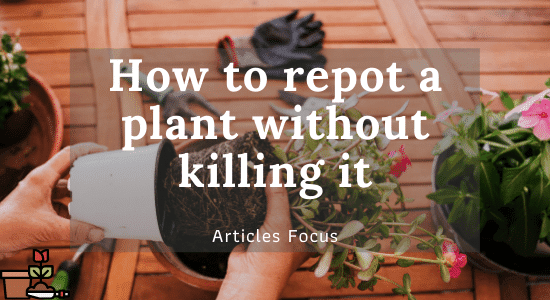Are you facing trouble while changing the pot of your plant or having too many questions How to repot a plant properly, How to know when to repot a plant? So, don't worry all your answers are in one place.
In this article, we will give you all the solutions to the problems that you facing while repotting your plant.
For potted flower plants, changing pots is a necessary and sometimes necessary management method, or because the original pots are too small and the roots of the plants do not have more space for free distribution, or the plants have rotten roots, they need to be replaced in time.
Treatment, or because of the transplanting of seedlings in pots or sub-pots, etc. In short, it is very necessary to change pots for flower plants.
In order to smoothly change pots of flower plants, minimize the damage caused to flower plants by changing pots, and promote the restoration of normal growth of plants, the work of pot replacement needs to be carried out in accordance with strict procedures and operating specifications.
So, How to repot a plant without killing it? Let's see what precautions we should take care of for flower and plant repotting.
{tocify} $title={Table of Contents}
Precaution: How to repot a plant without killing it?
1. The season must be right
Many plants will die after repot because most people don't know when to repot a plant, they don't check the appropriate time that's why their plants/flowers die.
Changing pots for flower plants is very important in seasons because different seasons have different climates. Only by choosing the right season to change the pots, the damage to the plants will be less when the pots are changed, so it is easier to take the plants after they are potted.
The basin survives.
Flower plants are generally replaced in spring or autumn. The temperature in these two seasons is generally kept between 15°C-25°C, which is more suitable for changing pots, and it is difficult for plants to die after changing pots.
2. Sufficient preparation
Before changing pots for flowers and plants, preparations must be done. In addition to preparing all the materials needed, it is usually necessary to artificially create conditions suitable for changing pots.
For example, water the plants once before changing pots, and then wait for 3-5 days to change the pots when the soil is not dry or wet. Because this is the best time to depot the plants, it is not only very easy to depot but also reduces damage to the root system.
3. Keep the soil ball adheres to the roots
The soil ball is the soil that adheres to the roots of the flower plants. Everyone try to keep the soil ball when changing the pot.
Generally, putting the soil on the pot is more conducive to the survival of the plant. At least do not remove the old soil from the roots, and you need to keep more than one-third of the old soil adhering to the roots, so as to ensure that the plants survive smoothly after changing pots.
Sometimes in order to facilitate root repair, we can properly remove some old soil from the roots of the plant, but it is usually appropriate to keep one-third to two-thirds of the soil.
4. Correct root repair
Root pruning is a very important part of the process of plant changing pots.
Generally, pruning the main roots as little as possible, focusing on pruning the capillary roots and fibrous roots around the roots.
After root trimming and potting, as long as the environment is suitable, these capillary roots or fibrous roots will grow out quickly, and their ability to absorb nutrients is very strong.
But if the part of the taproot is cut off, not only is it easy to affect the plant's serving, but it is also more difficult to grow out.
This is the most important part to properly repot a plant.
5. Choose the right basin
To change pots for flowers and plants, new pots are indispensable, and the choice of new pots is very important, and the requirements cannot be too large or too small.
This is just like a person choosing clothes. Clothes that are too large or too small are often not suitable for people to wear.
Naturally, it is not comfortable for people to wear them. The same is true for flowers and plants, so the size of the pot should be moderate, one size larger than the original pot.
Moreover, the pots should not be changed too frequently, otherwise, it will have a greater impact on the growth of plants, and it is more appropriate to keep most plants changing pots every 1-2 years.
6. Placement of new pot
After changing pots, the plants have a slow seedling process to adapt to the new environment, so it is very important to choose a location.
Generally, just place the plants in a cool and ventilated place for the slow seedling. During this period, you need to pay attention to shading and moisturizing and do not place them directly in the sun.
If it goes well, generally after about 1 week, the plants can survive and resume normal growth after serving, and then we can manage them in accordance with normal maintenance methods.
At the End
I hope all these precautions would help you to properly repot a plant without killing it. If you miss any of the above-listed precautions there would be more chance of facing trouble in the growth of plant or flower.
If you find this helpful, make sure you share this information with your friends and neighbors and else who is facing trouble in changing their pot to put a step ahead to help society.
Read Also-

